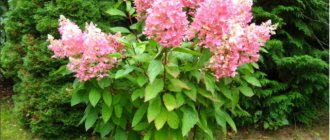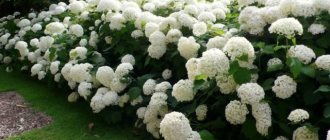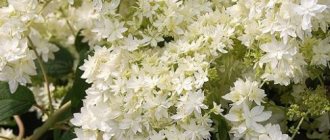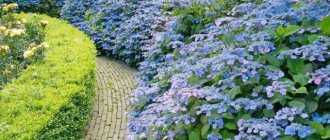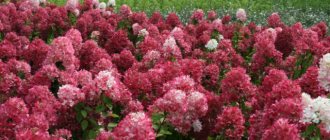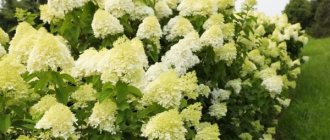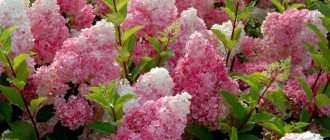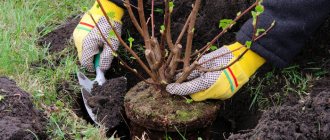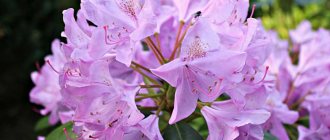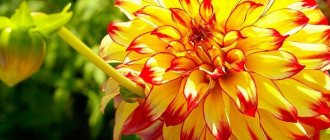Hydrangea Diamond Rouge. Description of the plant variety
Hydrangea Diamond Rouge (photo and description are presented in the article for informational purposes) is presented in the form of a bush or a small compact tree. The crop grows approximately 1.5 m. The crown diameter is approximately 1.4 m. After planting, the shrub begins to become covered with inflorescences after 3 years. The garden crop prefers to grow in sunny or semi-shaded areas. The shrub loves moisture very much, so it requires regular irrigation with water.
Characteristics of the features of the Diamond Rouge variety:
| Name of plant parts | Short description |
| Foliage | Characterized by an elongated and elongated shape. The plate is velvety and pubescent. During the flowering stage, the color of the leaf blade can change from green to orange. |
| Root system | It is of a superficial type and spreads beyond the crown. Every year during the spring period it is necessary to mulch the surrounding shrub circle. Due to this, moisture will be retained in the soil layer longer and will preserve soil fertility. |
| Flowers | They are large in size and collected in inflorescences. The latter have a paniculate shape. The length of the inflorescence is approximately 40 cm. It is formed on the shoots of this year. During the flowering period, the petals are initially white, which changes to pink over time. With the onset of the autumn season, the flowers turn red. |
The change in shade is affected by the weather and climate, compliance with the rules of agricultural technology and the composition of the soil layer. The shrub begins to bloom from the 20th of June. The flowering stage lasts until early autumn.
Hydrangea paniculata Diamond Rouge: planting and care
This is a light-loving plant, but also grows well in partial shade. Hydrangea paniculata Diamond Rouge is usually planted in open ground in autumn or early spring. It does not tolerate dry seasons well, but the plant thrives in moist soils. That is why it is necessary to carefully monitor the quality of watering.
The planting hole should be made quite wide - at least seventy centimeters in diameter. This is necessary to ensure that the roots are distributed evenly. It is filled with a portion of organic and mineral fertilizers and well moistened. It is important to know that when planting a seedling, you should not bury the root collar. A well-compacted hole filled with soil must be watered abundantly.
Hydrangea Diamond Rouge can be planted in open ground in the fall, but only in the southern regions. Before planting a seedling, you need to choose the right place. And in this case, several factors are important.
Illumination
This type of hydrangea does not tolerate direct sunlight, so semi-shaded areas are most suitable for it. In the sun, hydrangea grows poorly, its inflorescences become smaller.
The soil
Hydrangea Diamond Rouge, planting and caring for which is not too difficult even for a beginner in floriculture, prefers clay or loamy fertile soil. It practically does not develop in sandy soil. For this variety, loose, organic-rich, fertile, moderately moist soil with a neutral or acidic environment is most suitable. On such soil, the flowers acquire a more saturated shade.
An acidic nutrient medium for this luxurious plant can be created using ordinary whey. When it gets into the soil, its bacteria will create an environment favorable for the plant. In addition, you can acidify the soil by introducing sawdust, half-rotted pine needles, and brown peat into it.
Humidity
Hydrangea Diamond Rouge is a moisture-loving plant, so it does not tolerate being in the vicinity of similar moisture-loving plants. It is more advisable to plant ground cover flowers, for example, saxifrage, under the crown.
Plant conditions
The plant is not picky about its conditions, however, some factors such as humidity, lighting and the quality of the soil layer must be taken into account.
Lighting
The Diamond Rouge variety requires a little darkening because it is difficult to withstand ultraviolet radiation. Therefore, under the influence of the sun's rays, you can observe the growth of the bush stopping and the inflorescences shredding. In the open sun, the foliage of the plant may get burned and the flowers may burn. The best place for planting is considered to be soil that is shaded by other plants. If this is not possible, temporary protection should be built in the form of a screen that will cover the hydrangea from the sun and strong side winds.
The protection should be constructed so that the plant is exposed to the sun during the daytime.
Temperature
The plant is very thermophilic, but can also be cultivated in cool climates. The normal temperature for development is considered to be 25 °C. When artificially protected from the sun, the plant is able to withstand elevated temperatures. The main condition is considered to be a moist soil layer around the trunk.
Humidity
To avoid competition, it is not advisable to plant hydrangea next to plants that love moisture. It is best to place the flower under the crown of ground cover varieties, for example, under saxifrage. Despite the fact that the plant loves moisture, it is not recommended to plant it near groundwater. Excess moisture will negatively affect the wintering of the plant and cause its death.
Soil and drainage
The variety loves clay and loamy soil layers. The plant does not grow in a sand-based substrate. This is explained by the fact that all the nutrients in the sand are washed out quite quickly, which can provoke their deficiency and starvation of the plant. The optimal place for the culture is considered to be a loose, organic-rich soil layer with a pH level within 5.5 units. The brightness of the inflorescences is beneficially affected by the acidic soil layer, which forces gardeners to add whey to the soil layer.
The favorable environment necessary for the normal growth of hydrangea can be created by the bacteria that are present in it. It is permissible to acidify the soil layer with peat, half-ripe pine needles and sawdust. They should be added to calcareous or alkaline soil, which will become suitable for normal cultivation and growth of the variety.
A plant growing in a neutral environment will not die, but the inflorescences will be quite pale and less attractive.
Watering
The hydrangea variety is considered a very moisture-loving plant that needs constant watering. The flower should be irrigated at least once every 7 days. In case of increased drought and high air temperatures, the plant will need to be watered 2 times more often. Depending on the type of soil layer and air humidity, in hot, dry weather the plant should be irrigated with water in a volume of 30 liters per 1 m2 of land. During the rainy season, watering should be carried out taking into account the humidity of the tree trunk. To nourish the root system of the crop, it is advisable to irrigate not under the trunk, but directly under the entire crown.
Hydrangea care
It is necessary to carefully care for the Diamond Rouge paniculata hydrangea. If the gardener does not make enough efforts, the optimal beauty of the shrub will not be achieved. Planted hydrangeas need to be properly watered and pruned . Also, do not forget about loosening the soil, fertilizing and protecting it before the onset of winter in order to enjoy beautiful flowers every year.
Important! The disadvantage of this crop is that replanting will be required if the plant is planted in the wrong place.
Watering
It is necessary to water paniculate hydrangea abundantly so that the plant does not experience moisture deficiency. This will also allow the root system to take root faster so that the bush is resistant to frost. Watering frequency - once every 7 days. For 1 m² you need to pour in at least 30 liters of water . If rainy weather prevails, it is better to increase the watering interval or pour in less water.
To disinfect the soil, add a little manganese . This will destroy all bacteria and prevent the development of diseases.
Top dressing
Plants need to be fertilized 4 times during the season:
- at the beginning of spring , when inflorescences form, it is recommended to use slurry (3 kg per 1 m²);
- during bud ripening, use superphosphate (200 g per 1 m²) or urea (150 g per 1 m²);
- when the buds are opening, use a set of mineral fertilizers “Royal Mix” (200 g per 1 m²);
- in the process of preparing the plant for winter, add superphosphate (150 g per 1 m²).
Trimming
Formative pruning is carried out according to the degree of need, when the shoots begin to escape from the crown . This will help maintain the beautiful shape of the bush.
Did you know? When Buddha's Birthday is celebrated in India,
it is customary to decorate not only the sacred temple, but also homes
with hydrangea It is believed that this brings happiness, prosperity and patronage of the deity. Also, do not forget to carry out sanitary pruning to protect the plant from diseases and pests. To do this, remove dry, diseased, wind- or snow-damaged branches. At intervals of 5 years, rejuvenating pruning is carried out, removing old shoots . Thanks to such actions, the growth rate of the bush and the beauty of the inflorescences are maintained.
Wintering
Despite the high levels of winter hardiness, the crop needs additional shelter. It is recommended to cover only the root system.
We recommend reading, Hydrangea paniculata: autumn care and preparation for winter.
The procedure is carried out according to the following principle:
- rotted manure is spread in a small layer - up to 10 cm;
- fallen leaves or peat are laid in a layer up to 15 cm high.
You should choose the shelter option that you consider more acceptable.
Methods of growing and propagating plants
The variety can be propagated by cuttings, seeds or layering. Seed propagation is difficult and costly, and does not guarantee the preservation of maternal characteristics in the crop. Hydrangea seeds are susceptible to disease, germinate poorly, and the first flowering may occur only after 4 years. Propagation by cuttings is based on the use of shoots of the current year. Cuttings from last year's shoots will not take root well. Since the flower is protected, it is very difficult to purchase planting material.
Reproduction
The most effective way to propagate Diamond Rouge hydrangea is cuttings. Planting material is cut from strong and healthy branches and placed in a vessel with water for a while. After this, they begin to form a cutting, on which at least three internodes should remain.
It is best to propagate Diamond Rouge hydrangea from cuttings.
The lower cut is dipped into a solution of a growth stimulator and the cutting is placed in a previously prepared container (approximately 2/3 deep). Then he is kept in a room for a year. As soon as stable warmth is established, young bushes can be transferred to the garden.
Attention! It is also known to propagate Diamond Rouge hydrangea by seeds, but it gives very poor results. The seedlings grow and develop slowly. Even if the most comfortable conditions are created, the bush blooms no earlier than after 4 years.
Propagation of Diamond Rouge hydrangea by layering is relatively easy. All you need to do is make a groove in the ground (about 20-30 cm) and bend down strong annual shoots. Shallow cuts are made on them with a sharp blade. For fixation, take any convenient weight.
The only condition is that the top of the shoot must be located above the soil surface in a vertical position. The top of the groove is sprinkled with earth and watered. You won't be able to see the young shoots of the Diamond Rouge hydrangea until next spring. They are not separated immediately, but wait another year. With this method of propagation, all varietal characteristics of the mother bush are completely preserved.
How to grow a plant: step-by-step instructions
Hydrangea Diamond Rouge (photos and descriptions will tell gardeners how to grow the crop in open areas) is cultivated at the beginning of the spring season at an optimal air temperature of +12 °C and soil layer +9 °C. In the northern regions, it is recommended to postpone planting to the beginning of May. This is required to reduce the likelihood of the plant wilting as a result of exposure to low temperatures.
When choosing planting material, it is worth considering the following features:
- age from 1 to 2 years;
- absence of diseases, stains, plaque;
- absence of mechanical deformations such as cracks, chips.
You can grow a plant by observing the following points:
- A planting hole measuring 50x50x50 should be dug the day before, watering it thoroughly. After a day, you need to install the drainage layer and directly plant the plant.
- A 10-centimeter layer of gravel or broken brick is suitable for drainage.
- Then you will need to prepare a nutrient substrate. To do this, in a large container you need to mix 2 parts of humus with the same volume of leaf soil, 1 part peat and 1 part sand. Then you need to add potassium sulfate with urea (in a volume of 25 g) and superphosphate in an amount of 60 g.
- The mixed components in the form of a slide should be placed on top of the drainage layer and the seedling should be placed on it, straightening its roots. The remaining substrate should be sprinkled onto the root system so that the root collar remains above the surface of the soil layer.
- Then you will need to spill the hydrangea with water and wait until it is absorbed. Next, you will need to loosen the soil layer and mulch it using sawdust, rotted peat or pine needles.
- If you plant several crops, you will need to maintain a distance of approximately 50 cm between them.
Growing and care
The French variety of hydrangea belongs to the light-loving varieties. But since direct rays of the sun can cause burns on its leaves and cause bright inflorescences to burn out, it is better to place the crop in partial shade. Ornamental shrubs will also not like strong wind.
For planting a flower with a spectacular appearance, it is recommended to use fertile, loose, moist soil with a pH of about 5.5. The more acidic the soil you choose, the brighter the inflorescences on the plant will be, and vice versa, a neutral reaction will make them paler. Diamond Rouge does not tolerate alkaline soil rich in lime, as well as sandy substrate, which quickly loses nutrients along with water. You can acidify the soil by watering it with whey.
The plant is planted in a hole with a diameter of 60 cm and a depth of up to half a meter. Drainage is required at the bottom of the hole. The most optimal composition of the soil mixture for varietal hydrangea: 2 parts of leaf soil, the same amount of humus, 1 part each of sand and peat. The root collar is not deepened when planting. At the end of the procedure, the crop requires abundant watering, followed by loosening and mulching. Keep a distance of at least 40 cm between plants.
The variety is very moisture-loving. Diamond Rouge does not tolerate drought well, and therefore the soil under the flower must be moistened as soon as it begins to dry out. To do this, use soft water at room temperature. The next day, after each watering, the soil is carefully loosened, trying not to damage the roots of the beauty.
In order for hydrangea to be strong and bloom profusely, it should be fed in a timely manner. In the spring, at the end of March and April, the soil under the flower is fertilized with organic matter. In summer, including in the phase of bud formation and at the beginning of flowering, the crop needs to be fertilized with a complex preparation or mixture rich in phosphorus. In August and September, the plant requires potassium-phosphorus fertilizers for successful wintering. Feeding the plant with potassium manganese in the form of a weak solution reduces the fragility of Diamond Rouge shoots. Fertilizers are applied to the soil 2 times a month.
The key to success when growing shrubs is its regular pruning. Every year in spring, healthy shoots of the plant are shortened by 2/3 of their length. These manipulations are carried out before the sap flow begins. This way you will achieve abundant and long-lasting flowering. Pruning should also affect twisted, diseased, damaged and dry stems. The same applies to the autumn event, but in addition it is worth removing dry hydrangea inflorescences.
Pests on Diamond Rouge may include aphids, spider mites, bugs, pennies, nematodes, and leaf rollers. With a low probability, it is capable of contracting tracheomycosis wilt and powdery mildew. For preventive purposes, treat the crop three times a season with solutions of insecticides and fungicides.
For the winter, the shrub is covered with rotted manure, peat or fallen leaves. You can build a frame over it and insulate it with film, turning the structure into a kind of greenhouse. Some experts recommend covering only young specimens.
Plant propagation instructions
To propagate a plant by cuttings, you must follow these steps:
- The cut piece of shoot should have at least 9 buds, provided that the lower cut is at a distance of 2 cm and the upper cut is 5 cm.
- The leaves located at the bottom must be removed, saving no more than 2, and the remaining foliage must be cut in half.
- The shoots should be placed in water for several days, and then treated with a growth stimulator.
- The cuttings will need to be rooted in a mixture based on peat and sand in a ratio of 2:1, deepening the workpieces by 2/3 and sprinkling the soil layer with sand.
- Then the seedlings will need to be covered with jars and placed in the shade.
- Containers for the winter should be placed in a cold room and their condition monitored so that fungus does not develop.
- After 12 months at the end of summer, it is permissible to send the seedlings to the soil layer, since shoots will form on them. If buds have formed by this period, it is recommended to tear them off so that the bush begins to gain strength faster.
It is permissible to propagate hydrangea using layering. To do this, you should dig a ditch and bend the shoots into it, after making cuts on each of them in 3 places. Then they need to be fixed with stones, sprinkled with a layer of soil and watered.
Shoots will appear by spring. This method of reproduction will preserve all parental characteristics.
Pest and disease control
Hydrangea Diamond Rouge (photos and descriptions will explain how to take care of the shrub during illness and insect infestation) is very often susceptible to pest attacks and diseases. Therefore, the plant needs to be given due attention.
The most dangerous insects for crops are:
- nettle weevil;
- spider mite;
- bedbugs;
- leaf roller;
- nematode;
- fawn leaf beetle;
- pennitsa;
- greenhouse tripa.
Pest control will require chemicals. For prevention, it is recommended to treat bushes with insecticides about 3 times per season. Diseases that can affect the plant include powdery mildew and tracheomycosis wilt. The first is a fungal disease, the sign of the formation of which will be spots with a dark coating. A pathogenic fungus located in the soil layer causes the formation of the disease. At high temperatures and humidity, it begins to actively operate.
The disease can be defeated in the early stages with soap shavings and copper sulfate, which are sprayed on the crop. Fungicides treat a plant with an advanced form of the disease.
Tracheomycosis wilt is caused by the remains of other plants that are located in the soil. The roots are initially attacked by infected mycelium, which grows through the shoots. A culture can die if the disease is not identified and no action is taken to eliminate it. All shoots that have been affected by the disease must be removed. The cutting area and the soil around the plant will need to be watered with a manganese solution. Powdered sulfur with wood ash should be used as a prevention of tracheomycosis wilt.
Why does the plant dry out and the leaves turn yellow?
The Diamond Rouge hydrangea may have leaves that turn yellow due to climate change or improper care. In rare cases, the plant is attacked by pests, which affects the yellowing of the green mass. If you initially choose the wrong place to plant a shrub, the leaves may turn yellow. If exposed to the sun for a long time, the leaf plate can turn yellow and get burned. If the soil layer remains dry for a long period of time, the plant's roots will begin to dry out and the foliage will begin to turn yellow and fall off.
The appearance of yellowness on the leaves can be caused by a deficiency of microelements in the soil. With the arrival of spring and before the summer season, the plant must be regularly fed with fertilizers. If the shrub grows in an alkaline soil layer, the leaves of the plant will constantly turn yellow. When a flower is affected by powdery mildew, its green mass changes its color to yellow. A gray coating forms on the reverse side of the leaf plate. In addition to yellowing of the foliage, the plant may dry out.
The reasons for wilting of shrubs are the following factors:
- during the process of transplanting to a new location, the roots were deformed;
- during irrigation, water fell on the leaves;
- the green mass suffers from chlorosis;
- the bushes froze during the winter season;
- violation of the watering regime;
- insufficient amount of sunlight;
- the soil lacks mineral fertilizers.
Reproduction methods
Diamond Rouge has fertile flowers, but the seeds can only ripen in the south. And all the same, the seedlings will give a split in varietal characteristics.
It is much easier to propagate hydrangea vegetatively:
- Semi-lignified cuttings in June or July. The shoot is divided into pieces with 2-3 internodes, the lower pair of leaves is removed, and rooted in water, perlite, sand, or a light substrate. In the fall, they are planted in the ground under a permanent shelter, or kept until the beginning of the next season in a frost-free utility room.
- Layering is the easiest, but unproductive method. In the spring, a good lower branch is tilted to the ground and buried. At the end of the current season or the beginning of the next, they are planted in a new place.
- By dividing the bush during transplantation.
Fertilizers for plants
Hydrangea Diamond Rouge (photos and descriptions will help novice flower breeders choose the right fertilizers for it and apply them to the soil) needs 4 feedings during the entire growing season. Thanks to this, the shrub will develop normally and become covered with inflorescences in a timely manner.
Mineral mixtures
During the period of bud formation, it is recommended to fertilize the soil layer near the hydrangea with urea, superphosphate or a composition that contains potassium. To increase the duration of flowering, the shrub needs to be fertilized with mineral fertilizers. The period for fertilizing will depend on the degree of flowering of the hydrangea. If all the buds have formed on the bush, the procedure can be carried out.
The last fertilizing needs to be done during the preparation of the crop for the winter period. For these purposes, it is advisable to use special chemical compounds that are suitable for hydrangeas. It is permissible to buy drugs in special flower shops.
Organic fertilizers
It is recommended to apply organic fertilizers to the soil layer with the onset of spring at the stage of formation of inflorescences. To do this you will need to use slurry. Ash is not suitable for feeding the Diamond Rouge variety. Organic matter reduces soil acidity. As a result, the color of the inflorescences will not be as rich.
To keep the bushes strong and not break, it is recommended to water the flower with a weak manganese solution. It is recommended to carry out the procedure 3 times per season.
Planting rules
Hydrangea Pink Diamond - description, planting and care
The plant is a light-loving plant, but readily develops in partial shade. The optimal time for planting in open ground is early spring or autumn. The crop is difficult to tolerate moisture deficiency and begins to wither in dry seasons, but actively develops in moist soil. That is why the gardener must carefully monitor the frequency and quality of watering.
The planting hole must be made wide enough, approximately 70 cm in diameter or more. This is due to the branched root system; all roots in the hole should be evenly distributed. Organic and mineral fertilizers are first added to the pit and watered abundantly.
You can plant Diamond Rouge hydrangea in open soil in the fall only in the southern regions. Before landing, you need to choose the right place; the tips listed below will help with this.
- This type of crop does not tolerate direct sunlight, so the optimal places for growth are semi-shaded. Under the scorching sun, its inflorescences begin to shrink and the plant slows down in growth.
- The soil. Hydrangea prefers fertile loamy or clay soils. It grows very poorly in sandy soil. The most suitable soil for plant development is loose structure, high concentration of nutrients, fertile, moderately moist with an acidic or neutral environment. When grown in such conditions, the flowers acquire a rich hue. You can create an acidic environment using ordinary whey. When it gets into the soil, it creates favorable conditions for the development of bacteria, the activity of which leads to acidification of the soil. An acidic environment is also created using brown peat, half-rotted pine needles and sawdust.
- Hydrangea Diamant Rouge is a moisture-loving crop, and therefore does not tolerate being adjacent to the same moisture-loving plants. It is recommended to plant under a canopy of ground cover flowers.
Hydrangea - planting
Algorithm for planting and replanting paniculata hydrangea:
- Pre-prepare a planting hole with dimensions of at least 40*50*50 cm. For some seedlings, larger sizes will be required.
- The process of planting or transplanting in total takes no more than two days. On the first day, the planting site is prepared and filled with plenty of water. It is important that the soil absorbs all the moisture.
- Immediately before planting, mineral and organic fertilizers are poured into the hole. Optimal composition: rotted humus, sand, peat and fertile soil.
- It is also necessary to add potassium sulfate, superphosphate and urea to the resulting composition. All components are thoroughly mixed and evenly distributed over the bottom of the pit.
- The preparatory work has been completed. Now the seedling is carefully lowered into the hole, and as it is filled with soil, it is compacted so that cavities do not form between the roots.
Important! The plant needs to be replanted if it was originally planted in a place unsuitable for its growth. The transplanted plant must be covered for the winter.
Possible difficulties in growing
When cultivating Diamond Rouge hydrangea in a garden plot, some difficulties may arise. The root system of the plant is of a superficial type, so the shrub needs to be irrigated quite often and heavily with water. Otherwise, the flower may dry out. If you do not carry out timely preventive procedures to prevent the risk of developing bacterial or viral diseases, the plant may become infected with powdery mildew. As a result, the bush may die.
Hydrangea Diamond Rouge is an excellent option for a flower bed.
Since hydrangea does not withstand severe frosts well, it is recommended to send the seedling outside in early spring or autumn. During this time, the bush will be able to adapt and prepare for the winter period. To prevent the bush from growing too much, it is necessary to regularly prune the plant.
Diseases and pests of hydrangea
Signs of powdery mildew may appear on the surface of hydrangea bushes of the Diamond Rouge variety : leaves and shoots become covered with a dense white coating. Treatment consists of spraying the plants with a solution of Bordeaux mixture (30 g per 10 liters of water). To cope with the symptoms of chlorosis (the tops of the bush dry out, the leaves dry out and fall off), they are treated with a solution of “Fitosporin” (50 g per 10 liters of water). Spraying against diseases is carried out at intervals of 3 weeks.
Hydrangea can also be affected by pests, in particular aphids and spider mites . The universal remedy “Aktara” (100 g per 10 liters of water) helps fight them. Spraying is carried out at intervals of 2 weeks.
Find out more about diseases and pests of paniculate hydrangea and methods of controlling them.
So now you know that growing Diamond Rouge panicle hydrangea is not difficult if you put in the effort. It is important to try to follow all the rules for planting and care so that the bushes retain their shape for a long time, and the inflorescences form large and bright. Thanks to simple steps you can decorate your garden plot with bright flowers.
Use in landscape design
Hydrangea Diamond Rouge, due to its bright shade, which can change depending on the season, is often used to create landscape interiors. The plant is suitable for single and group plantings. The description of the variety and photo will tell gardeners how to properly place the shrub on the site and what other plants it goes well with.
To create an unusual contrast in the garden plot, it is recommended to plant hydrangea near perennial conifers or evergreens. If desired, the area can be decorated with pine sawdust or stones to create a beautiful flower alley. The Diamond Rouge variety is suitable for decorating hedges. The flower harmonizes well with other flowering bushes.
Where to buy and cost of the plant
Hydrangea seedlings of the Diamond Rouge variety can be purchased in specialized nurseries or flower shops that cultivate garden plants. The cost of planting material will depend on the age, length of the seedling and the type of its root system. The price of a plant starts from 570 rubles.
The description and photo of the “Diamond Rouge” variety will tell novice growers how to care for hydrangea while growing the crop outdoors. A flowering bush requires regular irrigation and fertilizing. If all norms of agricultural technology are observed, the garden crop will grow and develop normally over a long period of time.
